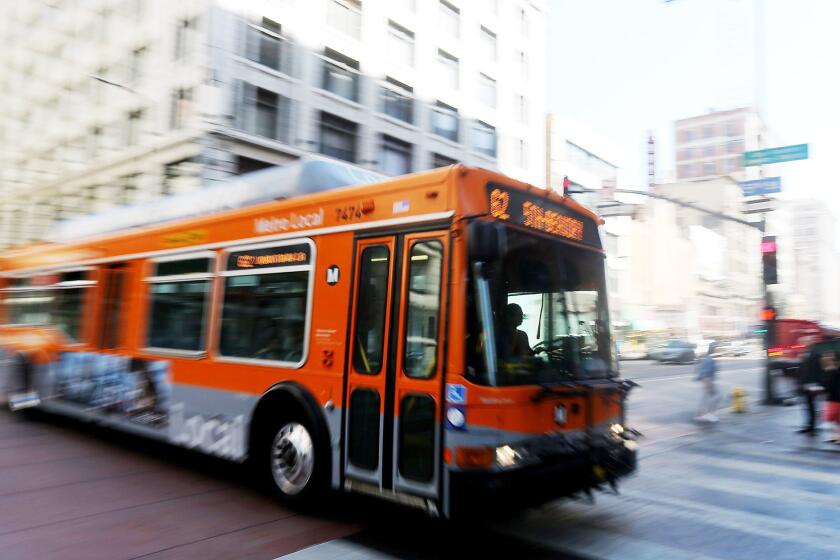Admittedly, They Have One-Track Minds
- Share via
FULLERTON — As the locomotive from Los Angeles roared into the station, Bernie Barnett waved to the engineer, gave the train a quick inspection and warned stragglers away from the tracks. Soon, as it began to pull out again, he hollered a triumphant “All aboard!”
Nearby, Barnett’s colleagues counted railroad cars, jotted notes and helped confused passengers with train schedules.
None of these men taking up their tasks around the 11:30 a.m. Desert Wind headed for Chicago were employees of the railroad. But they are here every day, suspenders hitched, caps pulled down, finding any reason to be near the objects of their affection: trains.
Railroad workers call them “foamers,” in joking reference to their enthusiasm at the sight of a diesel engine. You can see them every day and most nights at train stations and along railroad tracks throughout Southern California. Easily identified by the scanners most carry on their belts, they gather regularly along the tracks from Glendale to Tehachapi Loop.
The Fullerton train station has become a mecca for Orange County foamers, attracting an average of 25 every weeknight and as many as 40 on Saturday and Sunday. And almost every weekend, Cajon Pass in San Bernardino County is the site of a virtual “foamer festival” as dozens of Southern California train lovers gather to pay homage to the hurtling tons of sleek steel that give their lives meaning.
“There’s a sense of power in the trains,” said Bill Raymond, the public works superintendent for the city of Cypress who spends up to five nights a week at the Fullerton station and nearly every weekend at Cajon. “You can feel them inside you before you see them. You can be a romantic and think of all the places they’re going. I don’t like watching television, so I come here. It’s relaxing, it’s a getaway, and it’s just good clean fun.”
Ranging from preteens to seniors, the foamers come from all walks of life. Some, like the 77-year-old Barnett, are retirees attracted by the glamour and nostalgia of a previous age. Others are techies, interested in watching from front-row seats the evolution of a technology they find riveting. And some come just for the sheer sensual pleasure of feeling the vibrations in their bodies and the wind on their faces as hundreds of tons of machinery hurtle by at breakneck speeds.
“It’s the excitement of seeing all that power go by,” said Barnett, who for much of the past decade has spent at least five days a week watching trains in Fullerton and nearly every weekend doing the same thing at Cajon Pass. “It’s a pastime.”
Bill Crandall, 39, a professional drummer who spends several nights a week practicing his drumming by the tracks, said he has “always been intrigued by the light and the power.”
In the world of train watchers, Crandall is a “freight person,” one who specializes in freight trains, as opposed to a “passenger person” for whom passenger trains evoke the thrill.
“I do it for the fun,” he said. “It’s a hobby, and a cheap one.”
The hobby has been around as long as trains have crossed the nation, according to Ted Benson, a Modesto photographer who has published several books on trains. Sometime in the 1930s, he said, California’s contingent of rail enthusiasts began organizing clubs, starting magazines and branching out into such specialties as railroad photography.
Today, Benson estimates, the state has as many as 1,500 train buffs whom he would describe as “hard core” foamers, people who spend significant amounts of time watching trains.
“The term has become something of a badge of honor,” Benson said. “If you’ve been identified as a foamer, you’re definitely hard core.”
Bill Shippen, editor of a train lovers magazine published in Chico called Flimsies!, said he thinks “the number is starting to grow. I’m finding a lot of younger guys just getting into it and going whole hog.”
Shippen’s 1,600-circulation magazine, named after the old train destination orders once written on onion paper, operates a telephone hotline offering would-be foamers up-to-the-minute information on train schedules and train sightings nationwide.
Foamers cite various reasons for craving this esoteric information.
“I’ve always laughingly passed it off as a congenital birth defect,” quipped Benson, 48. “I think it’s one of those things you’re born with. My parents told me that it was the first thing I talked about when I was 3.”
Rail buffs, almost all of them male, recall becoming fascinated with trains as children as they watched the big engines roll through their hometowns or excitedly put together their first electric train sets at the knees of their fathers.
Ron Butts, 46, of Whittier dates his love of trains to the day he got his first Lionel train set. “As a child you just like things that are bright and make loud noises,” he said. “Today I just like things that are big and noisy and smelly.”
And Flimsies! editor Shippen blames his obsession on the day when, at age 13, he was invited by a friendly engineer into the cabin of a Sacramento Northern train for the six-mile trip from downtown Chico to the local airport.
“A lot of guys got their starts by being befriended by railroaders,” he said.
Some railroaders still welcome the attention. Bill Sheehy, conductor of the Desert Wind from Los Angeles to Las Vegas (a route being eliminated by Amtrak on Nov. 10), said he sometimes sees as many as 300 foamers lining the tracks. Most of them, he says, are unassuming and pleasant, sometimes even helping by reporting potential problems they notice on passing trains such as loose hoses or shifting loads.
“I think they’re great,” Sheehy said of the train fans. “They’re the nicest people you’ve ever met. They don’t bother us, and we enjoy them. They’re helpful, and they’re just great guys.”
Peter Hidalgo, a spokesman for Metrolink, tends to agree.
“They are an excellent source of statistics and history of the railroad,” he said. “We see them as a major support to us. They are important allies to our service, and we need that.”
But Mike Martin, a spokesman for the Burlington Northern-Santa Fe Corp., said foamers also can get in the way, sometimes by trespassing or taking company property for souvenirs.
“There are individuals within the rail fan community who, unfortunately, have given rail fans a bad rap,” Martin said. “If you talk to any railroader who’s been around for any appreciable length of time, you’ll find that he has a story or two about problems with rail fans.”
Such concerns, among other things, prompted railroad officials to recently erect an 8-foot-high, 8,500-foot-long fence and contract private security guards to keep foamers away from the tracks near Cajon summit. The result: grumbling among train watchers, who say that their access has been unfairly limited.
Yet the pastime survives, usually practiced by groups of tightly knit friends.
In the small San Bernardino County town of Devore near the mouth of the Cajon Pass, one such group meets daily under an olive tree near Joe’s Country Corner Cafe. On either side of the cafe, two sets of glimmering railroad tracks carry dozens of trains every day.
“It’s amazing the amount of tonnage that comes through here,” said Bruce Holleran, a 40-year-old plastics warehouseman from San Bernardino, who spends at least three evenings a week and just about every weekend watching trains here from his parked car. “What interests me most are the locomotives. They’re so majestic.”
In the car next to him, Wally Lehman, 73, a man who has spent so much time here for so many years that a hamburger was named for him at Joe’s, turned his attention to his scanner. It crackled to life with the voice of a railroad dispatcher broadcasting from Schanberg, Ill.
“It’s good to hear Clyde’s voice,” Holleran said. Then, “Have you seen Art lately?” he asked, referring to a train engineer both have waved to often.
“No,” Lehman replied, “but I’ve heard his voice a couple of times.”
More to Read
Sign up for The Wild
We’ll help you find the best places to hike, bike and run, as well as the perfect silent spots for meditation and yoga.
You may occasionally receive promotional content from the Los Angeles Times.






